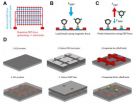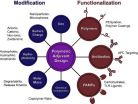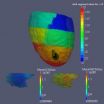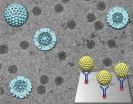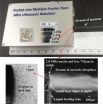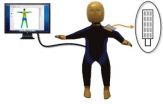(Press-News.org) A new type of biomolecular tweezers could help researchers study how mechanical forces affect the biochemical activity of cells and proteins. The devices — too small to see without a microscope — use opposing magnetic and electrophoretic forces to precisely stretch the cells and molecules, holding them in position so that the activity of receptors and other biochemical activity can be studied. Arrays of the tweezers could be combined to study multiple molecules and cells simultaneously, providing a high throughput capability for assessing the effects of mechanical forces on a broad scale. Details of the devices, which were developed by researchers at the Georgia Institute of Technology and Emory University in Atlanta, were published February 19, 2014, in the journal Technology.
"Our lab has been very interested in mechanical-chemical switches in the extracellular matrix, but we currently have a difficult time interrogating these mechanisms and discovering how they work in vivo," said Thomas Barker, an associate professor in the Wallace H. Coulter, Department of Biomedical Engineering at Georgia Tech and Emory University. "This device could help biologists and biomedical engineers answer questions that cannot be answered right now." For example, a cell that's binding the extracellular matrix may bind with one receptor while the matrix is being stretched, and a different receptor when it's not under stress. Those binding differences could drive changes in cell phenotype and affect processes such as cell differentiation. But they are now difficult to study.
"Having a device like this will allow us to interrogate what the specific binding sites are and what the specific binding triggers are," Barker explained. "Right now, we know very little about this area when it comes to protein biochemistry." Scientists have been able to study how single cells or proteins are affected by mechanical forces, but their activity can vary considerably from cell-to-cell and among molecules. Th e new tweezers, which are built using nanolithography, can facilitate studying thousands or more cells and proteins in aggregate. The researchers are currently testing prototype 15 by 15 arrays which they believe could be scaled up.
"For me, it's not sufficient to pull and hold onto a single protein," said Barker. "I have to pull and hold onto tens of thousands of proteins to really use the technologies we have to develop molecular probes."
At the center of the tweezers are 2.8-micron polystyrene microbeads that contain superparamagnetic nanoparticles. The tiny beads are engineered to adhere to a sample being studied. That sample is attached to a bead on one side, and to a magnetic pad on the other. The magnet draws the bead toward it, while an electrophoretic force created by current flowing through a gold wiring pattern pushes the bead away. "The device simultaneously pushes and pulls on the same particle," Barker explained. "This allows us to hold the sample at a very specific position above the magnet." Because the forces can be varied, the tweezers can be used to study structures of widely different size scales, from protein molecules to cells — a size difference of approximately a thousand times, noted Wilbur Lam, an assistant professor in the Coulter Department. Absolute forces in the nano-Newton range applied by the two sources overcome the much smaller effects of Brownian motion and thermal energy, allowing the tweezers to hold the cells or molecules without constant adjustment.
"We are basically leveraging microchip technology that has been developed by electrical and mechanical engineers," Lam noted. "We are able to leverage these very tiny features that enable us to create a very sharp electrical field on one end against an opposing short magnetic field. Because there are two ways of controlling it, we have tight resolution and can get to many different scales."
As a proof of principle for the system, the researchers demonstrated its ability to distinguish between antigen binding to loaded magnetic beads coated with different antibodies. When a sufficient upward force is applied, non-specific antibody coated beads are displaced from the antigen-coated device surface, while beads coated with the specific antibody are more strongly attracted to the surface and retained on it.
Barker and Lam began working together on the tweezers three years ago when they realized they had similar interests in studying the effects of mechanical action on different biological systems. "We shouldn't be surprised that biology can be dictated by physical parameters," Lam explained. "Everything has to obey the laws of physics, and mechanics gets to the heart of that." Lam's interest is at the cellular scale, specifically in blood cells.
"Blood cells also respond differently, biologically, when you squeeze them and when you stretch them," he said. "For instance, we have learned that mechanics has a lot to do with atherosclerosis, but the systems we currently have for studying this mechanism can only look at single-cell events. If you can look at many cells at once, you get a much better statistical view of what's happening."
"We are primarily interested in evolving antibodies that are capable of distinguishing different force-medicated conformations of proteins," he explained. "We have a specific protein that we are interested in, but this technique could be applied to any proteins that are suspected to have these force-activated changes in their biochemical activity." While the tweezers solve the specific experimental needs of Lam and Barker, the researchers hope to find other applications. The tweezers were developed in collaboration with graduate student Lizhi Cao and post-doctoral fellow Zhengchun Peng. "Because of the scale we are able to examine — both molecular and cellular — I think this will have a lot of applications both in protein molecular engineering and biotechnology," Lam said. "This could be a useful way for people to screen relevant molecules because there currently aren't good ways to do that." Beyond biological systems, the device could be used in materials development, microelectronics and even sensing. "This ability to detect discrete binding and unbinding events between molecular species is of high interest right now," Barker added. "Biosensor applications come out of this naturally."
INFORMATION:
Corresponding author for this study in TECHNOLOGY is Thomas Barker,
thomas.barker@bme.gatech.edu
For the paper, please visit http://www.worldscientific.com/doi/pdf/10.1142/S2339547814500058
Tiny biomolecular tweezers studying force effect of cells
2014-04-03
ELSE PRESS RELEASES FROM THIS DATE:
Enhancing the immune response through next generation polymeric vaccine adjuvants
2014-04-03
The great success of vaccines over the past two centuries as a preventive medicine has led to a significant reduction in morbidity and death caused by controllable infectious diseases. The effectiveness of vaccines is dependent on their ability to induce a protective immune response in recipients. Adjuvants, such as aluminum salts, have been integrated into vaccines for more than 70 years to augment the body's immune response to patho-gens. Adjuvants are especially necessary to boost the immune response for subunit vac-cines. However, conventional adjuvants are limited ...
Diffeomorphometry and geodesic positioning systems for human anatomy
2014-04-03
A team of researchers from the Center for Imaging Science at the Johns Hopkins University and the CMLA of the École Normale Supérieure Cachan have demonstrated new algorithmic technologies for the parametric representation of human shape and form. Coupled with advanced imaging technologies, this presents opportunities for tracking soft-tissue deformations associated with cardiovascular studies, radiation treatment planning in Oncology, and neurodegenerative brain illnesses. The software algorithms provide tools for basic science and pre-clinical investigations for synchronizing ...
Structural insights into the inner workings of a viral nanomachine
2014-04-03
Researchers at the Virginia Tech Carilion Research Institute (VTCRI) are using new nanoscale imaging approaches to shed light on the dynamic activities of rotaviruses, important pathogens that cause life-threatening diarrhea in young children. Once a rotavirus enters a host cell, it sheds its outermost protein layer, leaving behind a double-layered particle (DLP). These DLPs are the form of the virus that produces messenger RNA molecules, which are critical for launching the infection.
Researchers, Deborah Kelly, Ph.D. and Sarah McDonald, Ph.D., both Assistant Professors ...
A pocket-size ultrasonic nebulizer employing a novel nozzle improves inhalers
2014-04-03
Inhalation is an increasingly important route for non-invasive drug delivery for both systemic and local applications. Control of particle size and output plays a critical role in the efficient and effective delivery of oft en expensive medications to the lung. Drugs designed to treat pulmonary diseases or for systemic absorption through the alveolar capillary bed require optimum particle sizes (1 to 6 μm) for effective delivery.
A team of researchers from the Department of Electrical Engineering and Computer Science at the University of California, Irvine has realized ...
An ethics framework should be used to decide health standards for extended, exploratory spaceflights
2014-04-03
WASHINGTON – NASA should use an ethics framework when deciding whether, and under what conditions, spaceflights that venture outside low Earth orbit or extend beyond 30 days are acceptable if they do not meet current health standards, says a new report from the Institute of Medicine, the health arm of the National Academy of Sciences. Exceptions to existing health standards should be granted by NASA on a mission-by-mission basis, and any exceptions should be rare and occur only in extenuating circumstances. The report provides an ethics framework based on six principles ...
Research studies highlight advantages and potential of computer-guided spinal surgery
2014-04-03
LOS ANGELES (April 3, 2014) – In a series of research studies, Cedars-Sinai spinal surgeons show that a new method of computer-guided spine surgery is beneficial for spinal reconstruction and for treating complex tumors and degenerative spine problems, resulting in fewer complications and better outcomes for patients.
The Cedars-Sinai surgeons highlight the advantages of a "spinal navigation" technique that uses high-speed computerized tomography (CT) imaging to navigate in and around the spinal column from different angles. They present their findings in six articles ...
Between accident and real harm in child injuries
2014-04-03
Child abuse is a leading cause of fatality in children 0-4 years of age. Roughly 1,500 children are fatally injured each year in association with child abuse and 150,000 are permanently disabled. Many serious injuries and fatalities could be prevented if it was possible to distinguish between injuries associated with abuse and those caused by accidents. Clinicians, child protective services and law enforcement personnel should be equipped with improved knowledge related to the types of injuries that are possible from common household accidents that are often falsely reported ...
Scientists emphasize metabolites' role in understanding disease
2014-04-03
TUSCALOOSA, Ala. — Overreliance on genetic-centered approaches in predicting, diagnosing and treating disease will lead to few future scientific breakthroughs, cautioned a University of Alabama researcher who co-authored an article in an early online issue of Genetics that advocates for a greater emphasis on the body's metabolites in understanding illnesses.
"To augment the value of genetic data, the scientific community needs to add additional information from things like metabolomics – the analysis of metabolites within an organism," said Dr. Laura Reed, a University ...
How electrodes charge and discharge
2014-04-03
CAMBRIDGE, Mass-- The electrochemical reactions inside the porous electrodes of batteries and fuel cells have been described by theorists, but never measured directly. Now, a team at MIT has figured out a way to measure the fundamental charge transfer rate — finding some significant surprises.
The study found that the Butler-Volmer (BV) equation, usually used to describe reaction rates in electrodes, is inaccurate, especially at higher voltage levels. Instead, a different approach, called Marcus-Hush-Chidsey charge-transfer theory, provides more realistic results — revealing ...
An ultrathin collagen matrix biomaterial tool for 3D microtissue engineering
2014-04-03
A novel ultrathin collagen matrix assembly allows for the unprecedented maintenance of liver cell morphology and function in a microscale "organ-on-a-chip" device that is one example of 3D microtissue engineering.
A team of researchers from the Center for Engineering in Medicine at the Massachusetts General Hospital have demonstrated a new nanoscale matrix biomaterial assembly that can maintain liver cell morphology and function in microfluidic devices for longer times than has been previously been reported in microfluidic devices. This technology allows researchers to ...
